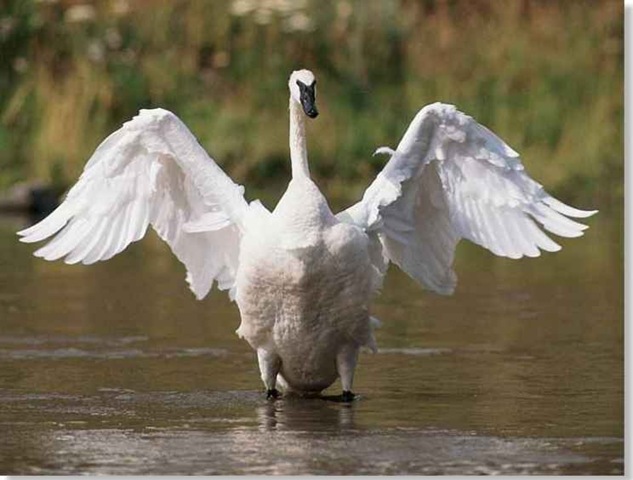ORDER
Anseriformes
FAMILY
Anatidae
GENUS & SPECIES
KEY FEATURES
• Floats gracefully in the water at rest, but swims and flies with extraordinary power
• protects the nest that it uses year after year by establishing a milewide territory
• Trumpets loudly, hence its name, to defend its nest in spring and summer
WHERE IN THE WORLD?
Found in the u.S. and Canada, from parts of Alaska east to Saskatchewan, south to Montana and wyoming; transplanted into refuges in Nevada
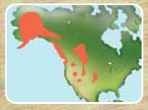
LFECYCLE
The trumpeter swan is the picture of elegance when swimming or flying, but it becomes fiercely protective of its family flock throughout the breeding season.
HABITAT
Once almost extinct, the trumpeter swan now numbers more than 10,000 and inhabits marshy areas in the northwestern U.S., including Alaska and southwest Canada. The swans have grown especially numerous in undisturbed regions with extensive beds of sedges, bulrushes and cattails. Trumpeters overwinter in areas with lakes and streams that do not freeze over. Still, these safe areas are scarce due to development and hunting. In an attempt to reestablish the species, swan conservationists have transplanted the birds to several refuges capable of supporting breeding and wintering swan populations.
Suitable surroundings
Trumpeters migrate to winter grounds that have lakes with abundant aquatic plants.
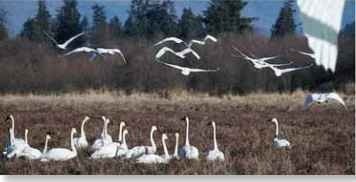
The female swan is called a pen and the male swan is called a cob — the young swan is a cygnet.
The trumpeter swan’s neck is twice the length of its body.
The syrinx, or sound-producing organ of birds, is extremely large in the trumpeter swan. It generates the deep “trumpet” tones when the swan forcefully exhales.
BEHAVIOR
Flying high During migration, trumpeter swans fly at great heights and speed.
Usually seen in a family flock of 3-5, the trumpeter swan may form larger social groups of 25-30 swans in the fall and winter. A mated pair selects a large, undisturbed home region in the spring that is usually defended until late summer; when cygnets (young) are half-grown.The pair can be quite territorial during breeding. Upon successfully driving other swans away, the male trumpets loudly sounding much like a French horn. Spending most of its time in the water and rarely feeding on land, the trumpeter often flies to an adjacent pond in search of food. Unable to spring directly from the water and fly, it uses its short legs to paddle clumsily along the surface for about 18′ before taking flight. When threatened, it dives underwater and clings to vegetation.Then it resurfaces, just showing its head. The swans are flightless during molting, with nonbreeding swans molting first, then males. The females molt last.Waiting until the males molt, the females stay at the nest to guard the young, which cannot fly, against predators.
FOOD & FEEDING
A swift and powerful swimmer, the adult trumpeter swan spends up to eight hours weeding out the 20 lbs. of vegetation that it eats each day. In shallow water, the trumpeter swan gathers the stems and leaves of sage, white-water buttercups and pondweeds by delicately submerging its head and neck under the surface. The trumpeter even digs holes with its strong feet to expose tubers. In deeper water, the trumpeter swan tips its head down and its tail up, similar to a duck, to snap off parts of plants on the bottom of the marsh. Waterweeds are a favorite food, and the seeds of the yellow pond lily and water shield provide a tasty snack.
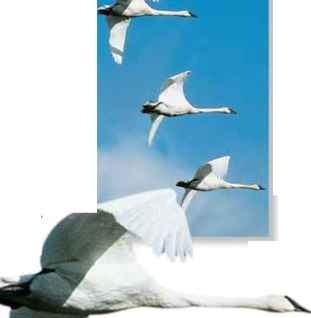
Aquatic Agility While feeding, the trumpeter swan takes full advantage of its long, flexible neck.
BREEDING

Mates are chosen at 2-3 years of age, and pairs usually stay together for life.The courtship ritual includes slow synchronized swimming, blowing in the water and bill-dipping. On the fourth or fifth dip, the male crosses necks with the female to cement their bond. In April, both swans build the nest in water 1-3′ deep. It will be used for several consecutive years.The uprooted marsh plants around the nest leave a large ring of open water for good visibilityThe nesting pair does not tolerate other trumpeters in its territory, so nests are usually 0.5 mile apart.
The female incubates the off-white eggs, which are stained brown by nest materials, and covers the nest with debris before leaving to find food. In June, the newly hatched white or gray cygnets weigh 7-8 oz. each. Within their first days, cygnets go with their parents in search of food. By their tenth week, they weigh 19 lbs. and by October have had their first flying lessons.
A NEW FAMILY
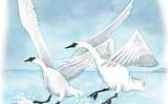
-
Still newlyweds…
At 4 years of age, two young trumpeter swans have been a pair for two years, but the female will lay her first eggs this season.
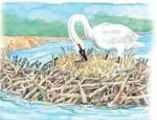
Preparing the nursery…
The female swan tucks marsh grasses that the male has uprooted into the large nest, which measures over 6′ in diameter

A close watch…
After laying eggs for six days, the female keeps a close eye on them. Each egg measures 4.5″ and weighs 12 oz..The male patrols the area.

Family outing
The cygnets have hatched after a 33-day incubation. At 3 days old, they paddle in the water with their parents for the first time.
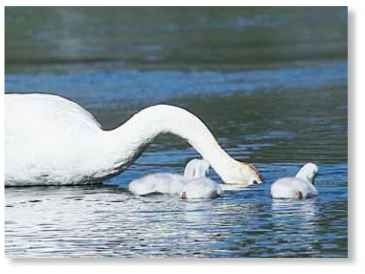
CONSERVATION
In 1932, the trumpeter swan was thought to be on the verge of extinction.After being overhunted for its feathers, which were used for pillow stuffing, and for its porous skin used for gloves, the trumpeters’ numbers plummeted to under 100 in the Red Rock Lakes in Montana. In 1935, Congress set this area aside as a National Wildlife Refuge, hoping to save this species. In 1954, other trumpeters were discovered in Alaska, and since then populations have steadily increased. Strictly protected in Canada and the United States, the main challenge for the swan is to reestablish migratory routes and find wintering areas with abundant food supplies.
PROFILE
Trumpeter Swan
North America’s largest waterfowl, the trumpeter swan uses webbed feet for strong swimming and an 8′ wingspan to reach air speeds of 80 mph.
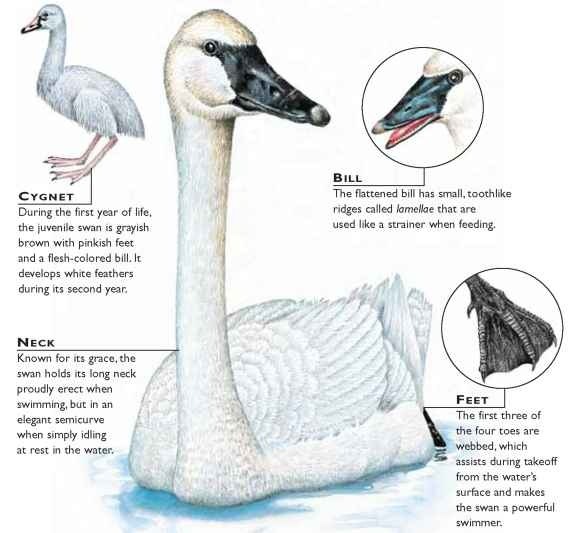
CREATURE COMPARISONS
The black-necked swan (Cygnus melanocoryphus) is a South American relative of the trumpeter swan. Smaller than the trumpeter, the black-necked swan weighs up to 15 lbs. As its name implies, it has a black head nd neck, unlike the trumpeter, which has all-white plumage. It emits a soft, musical whistle, while the trumpeter blows loud horn notes. The black-necked swan lives in Brazil, Chile, Uruguay, Paraguay and Argentina. Unlike the trumpeter, it prefers open areas of water near the coasts. Rather clumsy on land, it searches in the water for aquatic plants and insects.
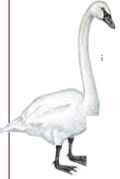
trumpeter Swan
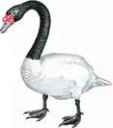
Black-necked swan
| VITAL STATISTICS Weight Male up to 38 1 lbs.; female up to 25 lbs. |
|
| Length | Male up to 62″; female up 1 to 58″ |
| Sexual Maturity | 4-6 years |
| Breeding Season | April-July |
| Number of Eggs | 1-9; usually 5 |
| Incubation period |
32-37 days |
| Fledging Period | 13-17 weeks |
| Breeding Interval | 1 year |
| Typical Diet | Marsh and aquatic plants |
| Lifespan | Up to 32 years in captivity |
RELATED SPECIES
• The family Anatidae consists of swans, geese and ducks, numbering more than 145 species worldwide. All three have common characteristics but also some differences. The seven species of swan are characterized by long necks; males and females have similar plumage. Male ducks have brighter plumage than females. Female geese have low voices; female swans have high voices.
